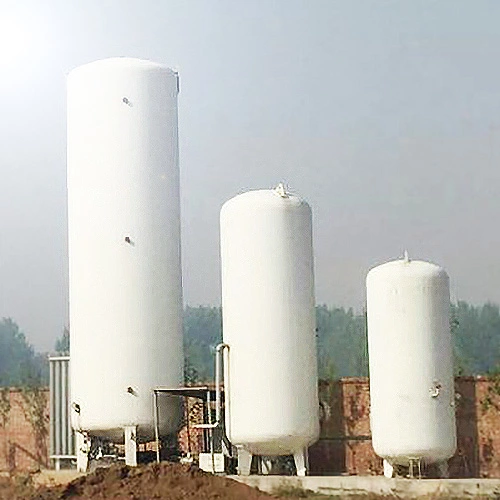1. Low pressure (L) vessel: 0.1MPa ≤ P < 1.6 MPa
2. Medium pressure (M) vessel: 1.6 MPa ≤ P < 10 MPa
3. High pressure (H) vessel: 10 MPa ≤ P < 100 MPa
4. Ultra high pressure (U) vessel: P≥100 MPa
Second, according to its function in the technological process:
1. Reaction pressure vessel (R): a pressure vessel mainly for performing physical and chemical reactions of a medium. Such as reactor, reaction still, decomposition pot, vulcanization tank, decomposition tower, polymerization tower, autoclave, super autoclave, synthesis tower, converter, digester, rotary spherical digester, still kettle, gas producer, and the like.
2. Heat exchange pressure vessel (E): a pressure vessel mainly for completing heat exchange of the medium, such as shell-and-tube heat recover steam generator, heat exchangers, coolers, condensers, evaporators, heaters, sterilizers, dyeers, dryers, steamers, preheaters, solvent preheaters, desolventizer, electric steam generator, gas producer water jacket, etc.
3. Pressure vessel separator(S): a kind of pressure vessel mainly used for completing the fluid pressure balance and buffering of the medium and gas purification and separation. Separators, filters, oil collectors, buffers, scrubbers, absorption towers, copper wash towers, drying towers, strippers, gas-distributing cylinder, deaerators, and the like are all pressure vessel separators.
4. Storage pressure vessel, or pressure vessel container (C, wherein the pressure vessel ball pot is B): a pressure vessel mainly used for storing and containing media such as gas, liquid and liquefied gas, such as various types of storage tanks.
Third, comprehensive classification
1. Fixed pressure vessel: the service environment is fixed and cannot be moved. There are many kinds of working media, most of which are toxic, flammable, explosive and corrosive dangerous chemicals. Spherical storage tanks, horizontal storage tanks, various heat exchangers, synthesis towers, reactors, dryers, separators, shell-and-tube heat recover steam generator, and manned containers (such as medical oxygen chambers) are all fixed pressure vessels.
2. Mobile pressure vessel: It is mainly used on the move, which is carried on the transport, as a package still for a certain medium. Most of the working media are flammable, explosive or toxic. The tanks of tankers and railway tankers are mobile pressure vessels.
3. Gas cylinder type pressure vessel: As a kind of pressure vessel, the gas cylinder type pressure vessel has a very large social possession, such as high-pressure gas cylinders (like hydrogen, oxygen, nitrogen bottles) and low-pressure gas cylinders (like civil liquefied petroleum gas cylinders). Most of the working media are also flammable, explosive or toxic. It also has a strong mobility, both long-distance movement during transportation and short-distance movement in specific use. Liquefied petroleum gas cylinders, oxygen cylinders, hydrogen cylinders, nitrogen cylinders, carbon dioxide cylinders, liquid chlorine cylinders, liquid ammonia cylinders and dissolved acetylene cylinders are included in gas cylinder type pressure vessels.
Fourth, pressure vessel safety accessories
1. Safety valve: The function of the safety valve is to automatically open when the pressure in the equipment exceeds the specified requirements, and release the excess pressure in order to return the equipment to the normal working pressure state. After the pressure is normal, the safety valve closes automatically.
After the safety valve has been inspected, it is strictly forbidden to increase the setting pressure of the safety valve or invalidate the safety valve by means of weighting, moving the weight, and locking the valve disc.
2. Pressure gauge: The range of the pressure gauge should be compatible with the working pressure of the equipment, usually 1.5 to 3 times, preferably 2 times the working pressure. A red line should be drawn on the dial of the pressure gauge to indicate the maximum allowable working pressure. The connecting pipe of the pressure gauge should not have water leakage or steam leakage, otherwise the indication value of the pressure gauge will be lowered.
3. Rupture disk
4. Thermometer
5. Level gauge
6. Pressure reducing valve
7. Emergency cutting device: Its function is to quickly shut off the valve and quickly cut off the air source to prevent the accident from spreading and expanding when the pipeline and its accessories are broken and mishandled or a fire accident occurs near the tanker.
8. Safety interlock device for quick-opening type pressure vessel: Quick-opening safety interlocking alarm device is an effective measure to prevent accidents in quick-opening pressure vessels. Its role is:
a. When the quick opening reach the predetermined closing position, the interlock control function for boost operation can be performed;
b. When the internal pressure of the pressure vessel is completely released and the safety interlock device is disengaged, the quick opening interlocking linkage function can be opened;
c. It has an alarm function synchronized with the above actions.


 English
English Español
Español русский
русский